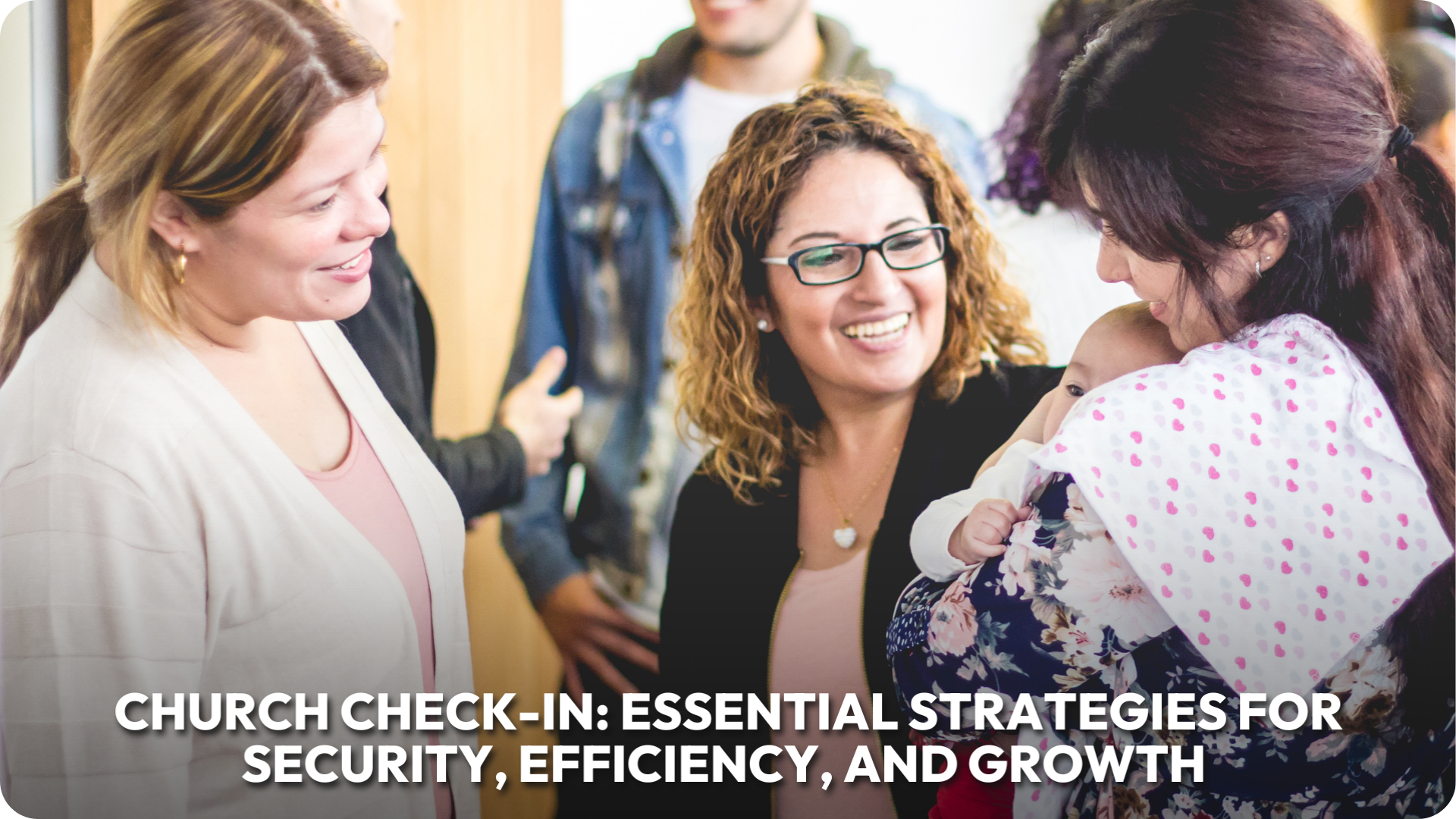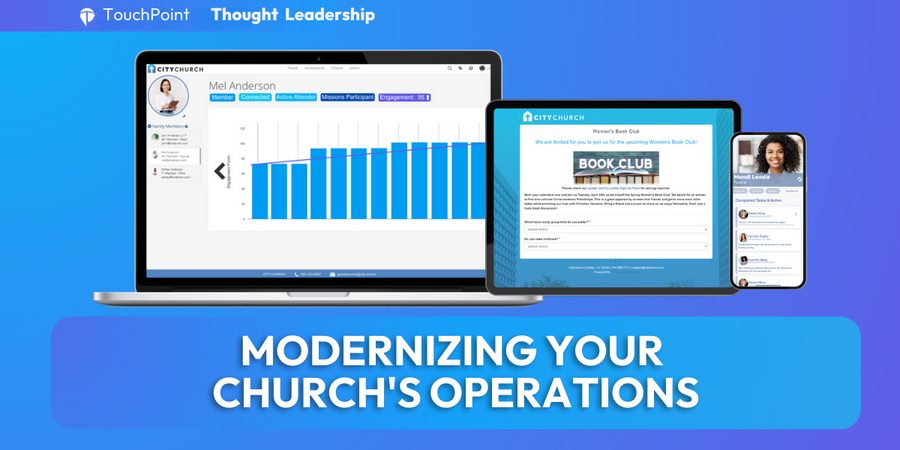In today’s church environment, ensuring the safety and security of children during ministry activities is paramount. Implementing an effective Check-In system not only safeguards children but also fosters trust among parents and streamlines administrative processes.
This comprehensive guide explores strategies for utilizing a church Check-In system, emphasizing children’s ministry while highlighting additional applications across various church events. While many church management softwares have the standard features and functionality that may seem commonplace, we’ve decided to include those “basic” principles and add an “elevated” idea or experience to implement as well.
1. Facilitating A Welcoming Environment For New Families
A well-implemented Check-In system serves as a vital connection point for newcomers:
Basic
Efficient Registration Process: Streamlined Check-In procedures make it easier for new families to register their children, reducing wait times and creating a positive first impression.
Elevated
Customizable Labels and Branding: Personalized name tags with the church’s branding can make new attendees feel welcomed and part of the community from the outset.
2. Enhancing Security In Children’s Ministry
A strong church Check-In system serves as the first line of defense in protecting children under the church’s care. Key components include:

Basic
Secure Tags for Pickup: Upon Check-In, each child receives a unique identification tag, and parents or guardians are provided with a corresponding tag. This matching system ensures that only authorized individuals can retrieve the child, significantly reducing the risk of unauthorized pickups.
Elevated
Check-Out Procedures: Implementing a check-out process allows the church to document when a child leaves the premises and with whom. This dual-record system provides a clear timeline of the child’s stay, enhancing accountability and security.
3. Streamlining Attendance And Data Management
Beyond security, Check-In systems offer valuable insights into attendance patterns and aid in efficient data management:
Basic
Automated Attendance Tracking: Digital Check-In systems automatically record attendance, minimizing manual errors and providing real-time data. This information is crucial for understanding participation trends and planning future events.
Elevated
Bi-Directional Communication: Two-way communication between your church Check-In system and your classrooms allows for a safe, secure, and personalized experience for your families. Utilizing a Check-In dashboard ensures that teachers and volunteers can see at a glance who is in their classroom and who is on their way. It also allows for immediate access to pertinent information, such as emergency contacts and medical alerts.
4. Expanding Check-In Systems Beyond Children’s Ministry
While primarily utilized for children’s ministry, you can disable secure tags or labels for other events. Check-In systems can be adapted and leveraged in other ways:

Basic
Volunteer Coordination: Implementing Check-In for volunteers helps monitor service hours, manage assignments, and recognize contributions, fostering a culture of appreciation and accountability.
Elevated
Event Management: For events like retreats, workshops, or community gatherings, Check-In systems can register attendees, print name tags, and track participation, ensuring organized and efficient operations. When the Check-In system records attendance, you now have a list of attendees you can communicate with in future follow-ups.
5. Leveraging Pre-Check And Mobile Features
Modern Check-In systems offer advanced features that enhance user experience:
Basic
Pre-Check-In Options: Allowing families to check in before arriving at the church via a mobile app reduces congestion at Check-In stations and provides a seamless experience.
Elevated
Mobile Integration: Mobile-enabled Check-In allows parents to use their smartphones for the process, offering convenience and aligning with contemporary digital habits.
6. Enhancing Safety Measures Against Potential Threats
A comprehensive Check-In system contributes to the overall safety of the church environment:

Basic
Restricted Access: Utilizing the Check-In system to control access to children’s areas and information ensures that only authorized personnel and parents can enter, preventing unauthorized individuals from gaining access. Maintaining a culture of safety by locking the manned station whenever it’s unattended is vital to protecting your church’s information.
Elevated
Background Checks: Integrating background checks for volunteers and staff into the Check-In system ensures that individuals working with children have been properly vetted, mitigating potential risks. When a volunteer checks in, have an easily identifiable way to show that a volunteer is up to date on their background check and safety training.
7. Customizing The System To Reflect Church Identity
Tailoring the Check-In system to align with the church’s identity enhances cohesion and recognition:
Basic
Branded Interfaces: Customizing the Check-In interface with the church’s colors, logos, and themes reinforces brand identity and creates a unified aesthetic.
Elevated
Themed Check-In Stations: Designing Check-In stations to reflect different ministries, events, or seasons adds a creative touch and engages attendees, making the process more enjoyable.
8. Preparing For Emergencies With Real-Time Data
In case of emergencies, having accurate, real-time data is crucial:
Basic
Emergency Notifications: Check-In systems can facilitate immediate communication with parents or guardians during emergencies, ensuring swift and coordinated responses.
Elevated
Accurate Headcounts: Real-time attendance data assists in accounting for all individuals during evacuations or drills, enhancing overall safety protocols.
9. Building Trust And Confidence Among Congregants
A transparent and efficient church Check-In system builds trust within the church community:

Basic
Parental Assurance: Knowing that the church has implemented stringent safety measures through the Check-In system reassures parents about their children’s well-being.
Elevated
Community Reputation: A church that prioritizes safety and efficiency through advanced Check-In systems enhances its reputation, potentially attracting more families and attendees.
Building A Safer, More Connected Church Community
Implementing an effective Check-In system is a multifaceted approach that enhances security, streamlines operations, and fosters a welcoming environment. By embracing innovative features and expanding the system’s use beyond children’s ministry, churches can create a safer, more organized, and engaging atmosphere for all attendees. Investing in such systems reflects a commitment to excellence and care, aligning with the core values of community and stewardship.
Is your church Check-In system meeting all your needs, or are you feeling limited by its functionality? A secure, efficient, and flexible Check-In process is essential for creating a safe and welcoming environment for families. With TouchPoint’s comprehensive Check-In system, you can enhance security, streamline attendance tracking, and improve communication between parents, volunteers, and staff—all while offering a seamless experience for your congregation. Don’t let outdated or inefficient processes hold your ministry back. Schedule a free demo today and discover how TouchPoint can empower your church with a safer, more connected Check-In experience.






